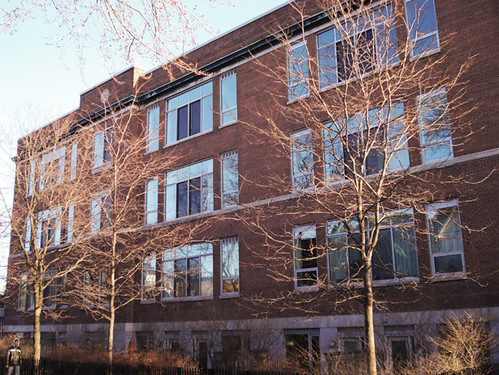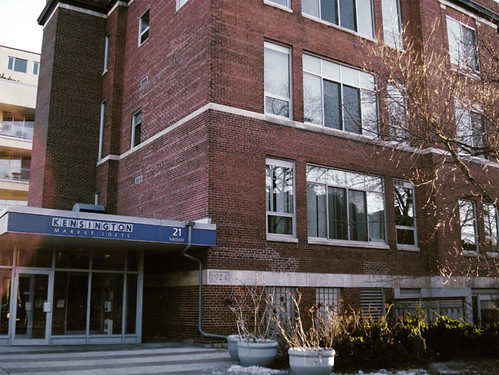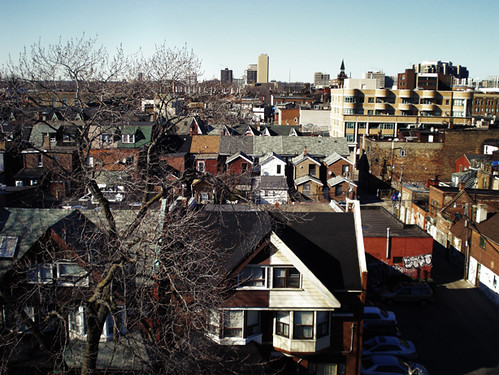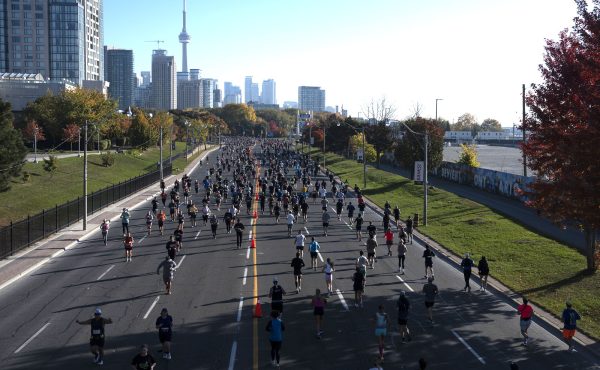

Across Ontario many communities are struggling with the loss of their small schools. Heritage schools are especially in danger; they have been for a long time and for a multiplicity of reasons. These places are unique, not only have they have played a significant role in defining the identity of generations of students, but they also define the character and quality of community life.
School enrollment has been rapidly decreasing for the last 25 years.In Toronto alone, elementary school enrollment decreased by over 35,000 students last year, a decline that is projected to continue. Peak baby boomer numbers, the reason so many schools were built in the fifties and sixties, will probably never be seen again.
Even with one of the fastest growing immigrant populations in North America, small Toronto schools can’t be filled fast enough, especially not in established residential areas where families tend to be older, exactly where heritage schools are likely to be found. Due to this declining enrollment school boards across Ontario have been forced to consolidate their small schools, and because heritage schools are more likely to need extensive maintenance they are most often chosen for closure. Despite the higher quality of craftsmanship of pre-WWII schools, these schools were built to meet different building and fire codes, and are often unfairly categorized as irredeemably unsafe.
It also doesn’t help that the standard Ontario school board utilizes a financing formula prescribed by the Ministry of Education that emphasizes the efficient use of space. Unfortunately, high ceilings, wide hallways and increased student space are penalized under this financing structure, and by default, so are many pre-WWII heritage schools. The cost to maintain more compact buildings is guaranteed to be significantly lower, especially when avoiding investment in adequate insulation and efficient heating strategies. But at what cost to the quality of student life? How effective can teaching be in box? Low ceilings mean low windows, less natural light and a higher reliance on fluorescent lighting, less airflow, and a lower aesthetic quality.
While there is funding available to school boards for the construction of new schools, there is no funding available for restoration initiatives. Heritage doesn’t even factor into the mandate of the Ministry of Education. But should it? The prime directive of the Ministry of Education, of any school board, of any school, is to consistently and evenly provide the highest quality education possible to the students under their jurisdiction.School boards really are the good guys, just not from a heritage perspective.
While I personally ascribe to the benefits of 14ft ceilings, large windows, and beautifully designed classroom space, there are a lot of other, more pressing issues effecting students today. I don’t think it’s reasonable to expect funds out of the Ministry of Education’s coffer to go towards protecting heritage features in lieu of educational programs. That the Ministry of Education has ‘No Policy’ that directly addresses heritage schools makes it evident that this is not something that they are willing to deal with. ‘No Policy’ speaks louder than any half-arsed policy ever would.

So how can communities protect their heritage schools? The first step is to designate, designate, designate. A community does not own its school, it’s a public environment that the public does not directly have any influence over. This is the very essence of what the Ontario Heritage Act is supposed to protect. Designation is the only mechanism that allows municipalities to manage changes in their cultural landscape, so that the heritage value of their communities can be protected. Designation tends to work the best when the built heritage of a place becomes so engrained in the fabric of the community that the community takes an invested interest in the future of that property. Unfortunately, designation does not guarantee long-term conservation, only effective use of space can protect a building from disintegrating into oblivion.
When the school board has closed a school, and if the school board decides it wants to sell the property, (which it might not) there is a generally accepted set of standards that directs the future use of that school. The school is usually offered first to any parallel school boards in the area. This may mean a public school is offered first to the Catholic board, or to any private or alternative schools in the area.
There is a dissonance, most prevalent in the GTA, between where students live and where the schools are. Schools in aging communities may run half-empty, while school properties surrounded by new housing are often riddled with ugly steel portables. In ten years these portable festooned schools will be facing the same drop in enrollment, the very reason why school boards are unwilling to invest in more permanent infrastructure, instead preferring what are essentially ‘throw-away’ schools. Alternative schools are one way of relieving this cycle of overcrowded/under-populated schools. Students are willing to be bussed in from a lot further away for the chance of a tailored education.
If there is no possibility of the property remaining as an educational facility, the property is usually then offered to the municipality. It’s important that the public investment into the property is maintained, community centres and arts facilities are popular options for heritage schools and easily find support, especially in an aging community.
If the municipality doesn’t want the property it can then be considered for adaptive re-use development. In many ways, despite being the last viable option considered, adaptive-re-use development is an ideal outcome for any abandoned school.
Kensington Market Lofts at 21 Nassau Street (pictured throughout) is one great example of an immensely successful sensitively adapted school building. Not coincidently Kensington Market Lofts also hosted “Preserving Heritage Schools†an awesome workshop that took place on February 28th, 2009, organized by the Architectural Conservancy of Ontario and Community Heritage Ontario.
Originally bought by the Toronto Board of Education in 1923, the school that is now Kensington Market Lofts first opened on September 2, 1925. Named after William Houston, a member of the Board of Education at the time and a political writer for The Globe and Mail, the William Houston Public School comprised of about 12 classrooms and had a capacity about 650 students.
The school went on to be occupied by Harbord Collegiate, the Ontario College of Art (now OCAD), the Ryerson Institute of Technology (now Ryerson University) and Provincial Institute of Trades (now George Brown College). During WWII the Canadian government used the buildings as a military school and for troop accommodation.
Because of the adaptive re-use of this building, this contextual history remains as significant part of the built fabric of the City of Toronto and the Kensington Market community, something that could not have been possible (even with a giant, flashy plaque) if the building was demolished.
While adaptive re-use is certainly more than heritage loft and condo conversions, it’s understandable as to why this has been seen as the ideal solution in the past. Heritage lofts and condos sell out faster and for more money than new constructions and, when undertaken by experienced professionals, require a comparative initial investment. ‘The Lazarus Effect‘, a study undertaken by the Heritage Resources Centre, affiliated with University of Waterloo, convincingly illustrates that not only can heritage development be profitable, but that anecdotally (as developers are generally very tight lipped about just how much money they make from any given project) such developments almost always deliver a greater Return on Investment (ROI).
Another successful argument for adaptive re-use is that it is the environmentally superior choice. A common misconception about the re-use of old buildings is that they are expensive to heat and wasteful spaces, insensitive to our changing environmental needs. While our obsession with reducing heating bills has certainly helped launch an awareness of energy waste and production, in the greater scheme of things it is relatively inconsequential.
The greenest building is always the already built building.
The amount of energy, money and manpower used to construct a building is phenomenal, and regardless of when that building was constructed the resources dedicated to it remain embodied in its structure. By demolishing a building and throwing its remains into a landfill, we are essentially wasting all of that embodied energy. Nevermind the resources required for destruction, all oil and bulldozers, rebuilding in the place of old is an inefficient use of energy and takes a much greater environmental toll than adaptive re-use.
This is the pattern of a throw-away society, something that we are hopefully trying to move away from. No number of fluorescent light bulbs could ever make up for the difference, while all an old building sometimes needs is proper insulation and extensive caulking.

(View from Kensington Market Lofts)
So why don’t more developers jump on such a profitable, planet-pleasing bandwagon?
Well, there are a lot of misconceptions out there getting in their way.
Banks are very wary of such undertakings, despite research and an extensive list of success stories to the contrary, and it is very difficult to convince a bank that heritage development is a worthwhile. This limits the development of heritage buildings to those who readily have the initial investment needed. While this is not as big of an issue in urban areas like Toronto, where there are smart, financially endowed investors abounds, it is a huge problem in smaller municipalities.
Another problem for smaller municipalities is that the renovation of under utilized buildings for new uses is sometimes not recognized by the municipality as development at all. In this case heritage developments don’t qualify for the same tax incentives and benefits that new developments do. In fact, most municipalities provide tax incentives for demolition.Probably the largest obstacle is a lack of experienced heritage developers. Inexperienced developers tend to shy away from adaptive re-use.
Demolishing and rebuilding without considering the implications is easy, while integrating an existing structure, although potentially more profitable, is much more complex. Although if we’ve learned anything from the impending environmental crisis, it’s that there are always implications, and there are no clean slates. Our heritage schools represent an amazing cultural resource, one that we can’t afford to send haphazardly to our landfills.




11 comments
Great article!
“So why don’t more developers jump on such a profitable, planet-pleasing bandwagon?”
Because it is tough, it is slow, and you don’t know what you are going to find behind the plaster or under the floor. You have to sell in advance at a fixed price but you really have no idea what it will actually cost. Kensington Lofts was my last project as a real estate developer and I am extremely proud of my accomplishments there, but it was tough.
But these buildings were built to last, can be more energy efficient than any new structure, are part of the fabric of our city and have stories to tell. Thanks for this article.
I was lucky to spend my high school years in such a school. Bishop MacDonell in Guelph was a slapdash assortment of buildings, from thirty to one hundred years old. Some joined to the others; some stood alone. They were built in a university-town’s downtown, on its highest hill, beside its grandest building: a cathedral-style church. No more adolescents will enjoy the casement windows of the art room, the separate field stone music annex, the sunny galleries on the first and second stories, or the staircased entrance from the main street.
The school has been moved 7km from the downtown, and all but the oldest buildings demolished. I suppose it is easier for students now to park, and buses to unload. This new ‘Bishop MacDonell’ has nothing to do with the school my brothers, friends and I went to.
You have correctly pointed out many of the reasons that these wonderful old buildings are lost. However, though you accurately lay the blame for this on the Ministry of Education’s door, this sentence is misleading:
“It also doesn’t help that the standard Ontario school board utilizes a financing formula that emphasizes the efficient use of space.”
That funding formula is imposed by the Ministry of Education on the school boards, who are hard pressed to ignore such formulas, though some have: Toronto Public, among others, refused to pass a balanced budget on meagre resources several years ago. The meagre funding formulas, though since improved, are a creation of the Harris government and that is where blame should lie.
Formulas know “the cost of everything, and the value of nothing.” But as you say, the cost of a basic retrofit is nothing compared to a complete rebuild. I am not happy to think of my old school saved as condos, though would be happier than what has happened to it. A good public building should remain public, so that the whole public can enjoy it, even if repurposed.
“The greenest building is always the already built building”
Amen to that.
Here’s another great example, though you have to see past 1999-style HTML and what passes for interior design in Cobourg. My grandfather attended this school when he was little and it’s great to see it re-used in some way.
http://mansionsongeorge.ca/index1
I’m glad you liked it!
And thanks Lloyd. There are a lot of foreseen and unforeseen obstacles to heritage development, something I can imagine can be stressful to say the least.
I’ve tried to clear that sentence up too jamesmallon!
Does asbestos have any influence on redevelopment prospects? Was it not a common material in buildings this age?
BTW, Toronto’s age demographics suck!
There is a beautiful example of a 1920s school building being renovated as a community centre in Stratford with the help of Loreena McKinnet.
Carleton Village Public School (near Davenport and Old Weston Rd) is an excellent current example of this issue. The property containing the original, Edwardian school building was recently purchased by the Toronto Police Service as the site for the new 11 Division HQ. Toronto Council voted against historical designation — largely, it seems, out of fear that the police would walk away and no buyer would ever be found. Local residents are desperately trying to have the old building preserved as part of the redevelopment.
The Toronto Police Service have a wonderful precedent for adaptive reuse with 51 Division at Front and Parliament.
I very much appreciate your interest in preserving large older downtown schools.
I have a parallel interest: looking towards preserving former rural one and two room schoolhouses. I have taken photos of over 200 such former buildings, mostly in eastern Ontario and western Quebec.
I recently created a website to reflect this interest and to promote preservation and restoration of such buildings. It includes many photos as well as some of my thoughts on the issue.
You are invited to visit my website at: http://heritageschools.bravehost.com/
Klaas Bylsma, Gatineau (Aylmer), Quebec